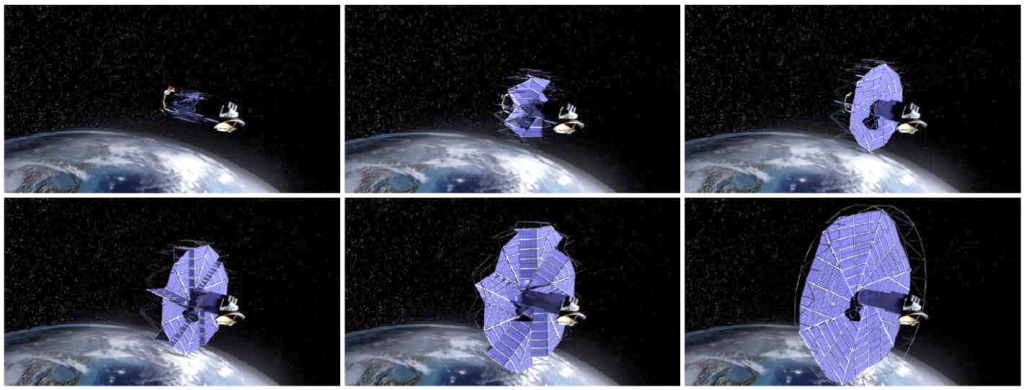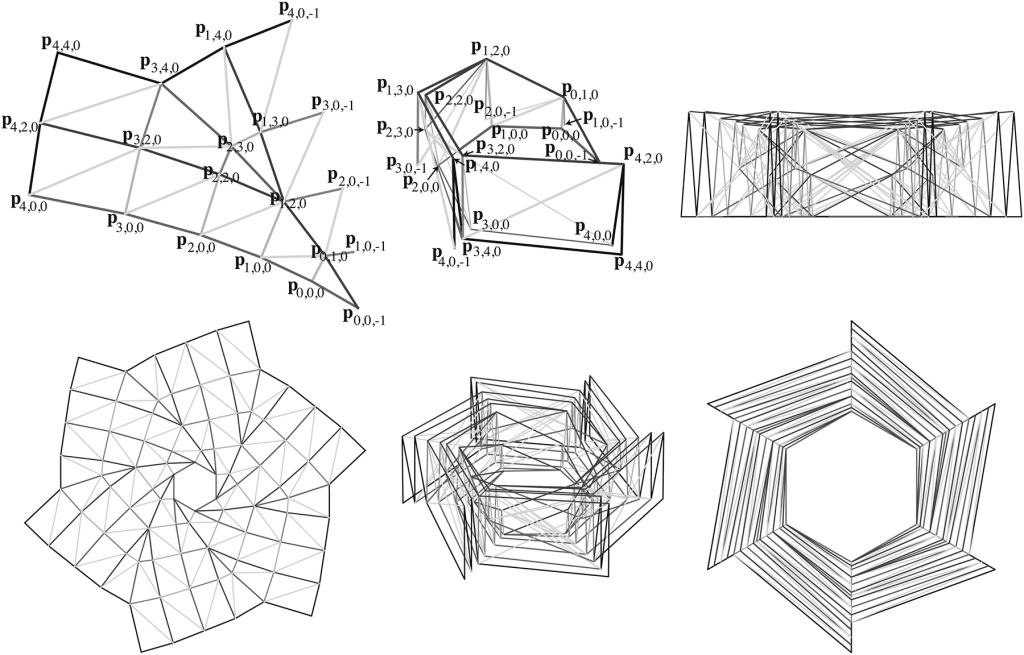Origami in Space
Origami Inspires Foldable Spacecraft Components And Space-Based Solar Power Arrays.
As a high school student at a study program in Japan, Brian Trease would fold wrappers from fast-food cheeseburgers into cranes. He loved discovering different origami techniques in library books.
Today, Trease, a mechanical engineer at NASA’s Jet Propulsion Laboratory in Pasadena, California, thinks about how the principles of origami could be used for space-bound devices.
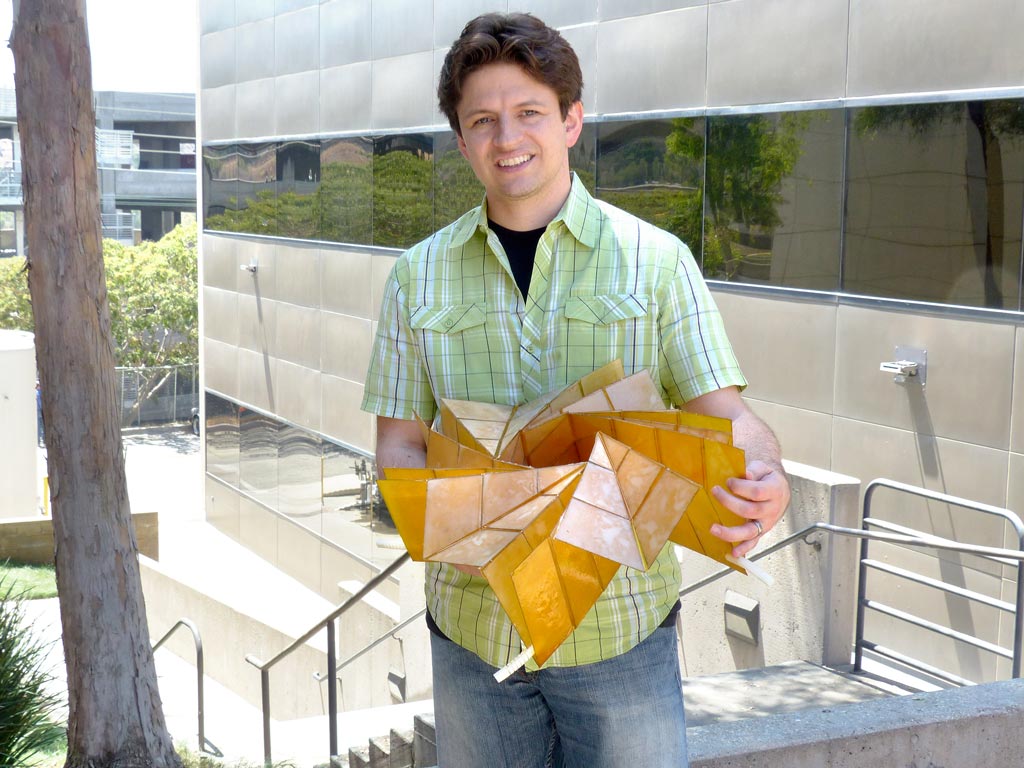
Brian Trease, a researcher at NASA’s Jet Propulsion Laboratory in Pasadena, holds a prototype of a solar panel array that folds up in the style of origami. (Credit: NASA/JPL-Caltech)
“This is a unique crossover of art and culture and technology,” he said.
Trease partnered with researchers at Brigham Young University in Provo, Utah, to pursue the idea that spacecraft components could be built effectively by implementing origami folds. Shannon Zirbel, a doctoral student at BYU, spent two summers at JPL working on these ideas, supported by the NASA Technology Research Fellowship, with Trease as her research collaborator.
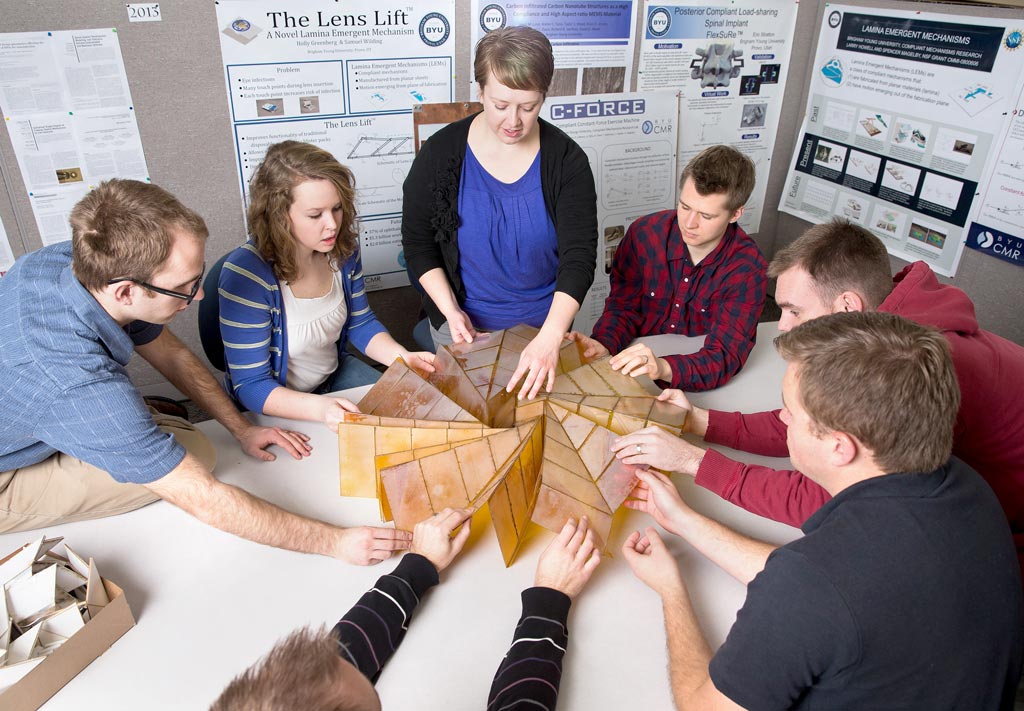
Mechanical engineering PhD student Shannon Zirbel (standing) and a team of students work on a solar array prototype that uses Origami. (Credit: BYU)
Researchers say origami could be useful one day in utilizing space solar power for Earth-based purposes. Imagine an orbiting power plant that wirelessly beams power down to Earth using microwaves. Sending the solar arrays up to space would be easy, Trease said, because they could all be folded and packed into a single rocket launch, with “no astronaut assembly required.”
Panels used in space missions already incorporate simple folds, collapsing like a fan or an accordion. But Trease and colleagues are interested in using more intricate folds that simplify the overall mechanical structure and make for easier deployment.
Last year, Zirbel and Trease collaborated with origami expert Robert Lang and BYU professor Larry Howell to develop a solar array that folds up to be 8.9 feet (2.7 meters) in diameter. Unfold it, and you’ve got a structure 82 feet (25 meters) across. Their 1/20th-scale tabletop prototype expands to a deployed diameter of 4.1 feet (1.25 meters).
One technique that has been used for an origami-inspired solar array is called a Miura fold. This well-known origami fold was invented by Japanese astrophysicist Koryo Miura. When you open the structure, it appears to be divided evenly into a checkerboard of parallelograms.
With this particular fold, there’s only one way to open or close it: Pull on one corner and — voila — the whole thing is open with minimal effort. The mechanical structure of a device that folds this way is greatly simplified because only one input is required to deploy it.
Miura intended this fold for solar arrays, and in 1995 a solar panel with this design was unfolded on the Space Flyer Unit, a Japanese satellite. Despite this test, the technology is still in its early stages. But now, with an emphasis on small satellites and large structures, Trease says arrays inspired by this fold could see renewed usefulness.
“The fact that we’re going both bigger and smaller may open up domains where it may be relevant again,” Trease said.
The fold that Trease and colleagues used is not a Miura fold, but rather a combination of different folds. Trease’s prototype looks like a blooming flower that expands into a large flat circular surface.
Trease envisions that foldable solar arrays could be used in conjunction with small satellites called CubeSats. And he says the origami concept could be used in antennas as well. It could be especially appropriate for spacecraft applications where it’s beneficial to deploy an object radially — that is, from the center, outward in all directions.
============================
A short video clip of the origami-inspired prototype
Origami was originally intended for folding paper, which has almost no thickness, so Trease and colleagues had to be creative when working with the bulkier materials needed for solar panels.
“You have to rethink a lot of that design in order to accommodate the thickness that starts to accumulate with each bend,” he said.
Origami has been the subject of serious mathematical analysis only within the last 40 years, Trease said. There is growing interest in integrating the concepts of origami with modern technologies.
“You think of it as ancient art, but people are still inventing new things, enabled by mathematical tools,” Trease said.
Source: Elizabeth Landau / Jet Propulsion Laboratory, Pasadena, California, USA.
======================================
Origami folds the key to future space exploration
Tony Hua tried his hand at origami in the past, but paper cranes and Hello Kitty pale in comparison to the origami-inspired endeavor he’s been a part of at the Jet Propulsion Laboratory this summer.
A senior at South El Monte High School, and founder of its Engineering Club, Hua, 17, landed a coveted high school summer internship at JPL alongside about eight other high school students, where he joined the research of the deployment of solar arrays that utilize the basic principles of origami — a Japanese art form that creates flashy designs like birds, flowers and cartoon characters by folding a piece of paper.
“The way it folds up is very unique compared to other arrays where it’s just a square piece that folds up,” he said. “So there’s definitely some art in there.”
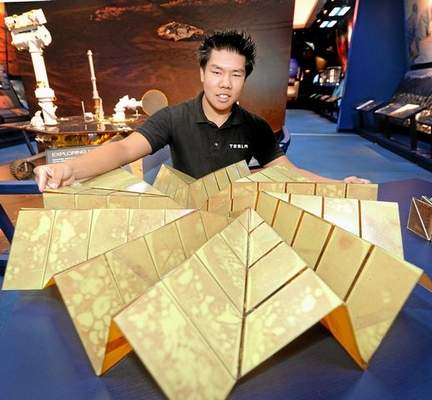
Hailed as one of the most outstanding high school interns the Jet Propulsion Laboratory has ever had, South El Monte High School student Tony Hua, 17, has helped engineer origami-inspired deployable solar arrays for use on future spacecraft designs. Hua deploys a 1/20 scale of a 25-meter solar array at the JPL Visitors Center on Tuesday. (Credit: Walt Mancini / Pasadena Star News)
It’s unlikely we will ever see crane-shaped or Hello Kitty-shaped deployable solar arrays bobbing through space — “those might not be very practical,” Hua said — but the origami-inspired arrays Hua has researched collapse down to about nine times their original size, then expand like unfolding a paper origami flower.
“They’re very aesthetic in their appearance in the way they fold, much like other origami,” said Brian Trease, a mechanical engineer at JPL and Hua’s mentor during his internship. “We cut it into pieces and reassembled in a certain way. Origami has ways. We’re allowed to break the rules for engineering purposes.”
The origami-inspired solar arrays use a rigid structure to safely fold into itself, keeping the array’s 90 individual solar cells sturdy.
“Fragile things like solar cells, which could just break when they’re bent, would be perfect for this solar array,” Hua said.
He said the design could also be applied in other applications.
Shrinking instruments to make for more room is a goal for current and future space exploration, according to Randall Foehner, a JPL mechanical engineer and the group supervisor of Hua’s internship group, division 38, which focused on mechanical deployables, actuators and booms.
“We’re trying to do more science with less spacecraft, so we’re miniaturizing everything,” Foehner said. “This technology, folding and storing in small volumes, is in perfect alignment with the future of a spacecraft and what we’re trying to do.”
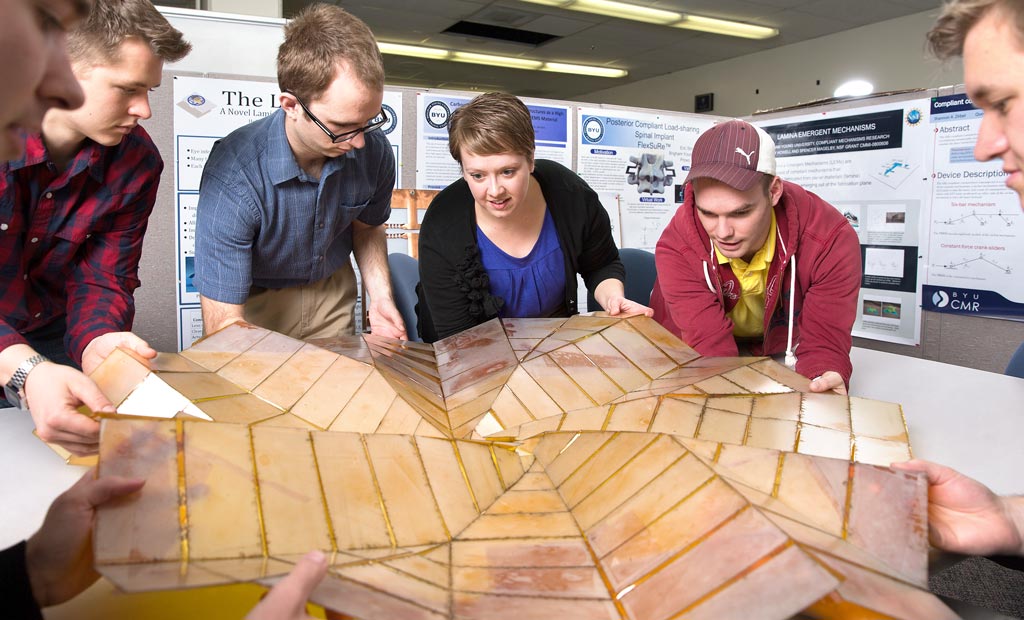
Shannon Zirbel and a team of students work on a solar array prototype that uses Origami. (Credit: BYU)
Of a $10,000 internal grant awarded to solar array research, $6,000 will fund further research of a solar array deployment method that Hua himself researched this summer.
“Most of them do not get to work with the research as hands-on as he has,” said Shannon Zirbel, who is seeking a doctorate and NASA Space Technology Research fellow at JPL.
The grant is funding a solar array prototype that utilizes a perimeter truss, a form of active actuation that would allow ground crews to open or close the deployable solar array at their discretion. It is expected to be completed by the end of September.
“Personally, I prefer passive actuation — it deploys by itself,” Hua said. “With NASA, they’re scared of something going wrong.”
Hua did not invent the perimeter truss or the origami idea, but assessed and modified a design that JPL officials developed last year.
Hua’s summer internship ended last week, closing with a presentation that recapped everything he had learned over the summer internship program.
Hua has been interested in engineering long before his internship at JPL — Hua and his Engineering Club peers made a solar-powered boat that won first place in the 2012 Solar Cup.
But his summer at JPL researching deployable solar arrays helped him decide that he wants to pursue mechanical engineering.
“I wasn’t sure what type of engineering I wanted to do until I came to JPL,” Hua said.
Source: Adam Poulisse / Pasadena Star News
================================
Origami in Space: BYU-designed solar arrays inspired by origami
=================================
Accommodating Thickness in Origami-Based Deployable Arrays
The purpose of this work is to develop approaches to accommodate thickness in origami-based deployable arrays with a high ratio of deployed-to-stowed diameter. The origami flasher model serves as a basis for demonstrating the approach. A thickness-accommodating mathematical model is developed to describe the flasher. Practical modifications are presented for the creation of physical models and two options are proposed: allowing the panels to fold along their diagonals or applying a membrane backing with specified widths at fold-lines. The mathematical model and hardware modifications are employed to create several physical models. The results are general and apply to a range of applications. An example is provided by the application that motivated the work: a deployable solar array for space applications. The model is demonstrated in hardware as a 1/20th scale prototype with a ratio of deployed-to-stowed diameter of 9.2 (or 1.25 m deployed outer diameter to 0.136 m stowed outer diameter).
Author: Shannon A. Zirbel, Robert J. Lang, Mark W. Thomson, Deborah A. Sigel, Phillip E. Walkemeyer, Brian P. Trease, Spencer P. Magleby and Larry L. Howell
Source: ASME, American Society of Mechanical Engineers (Founded in 1880)


